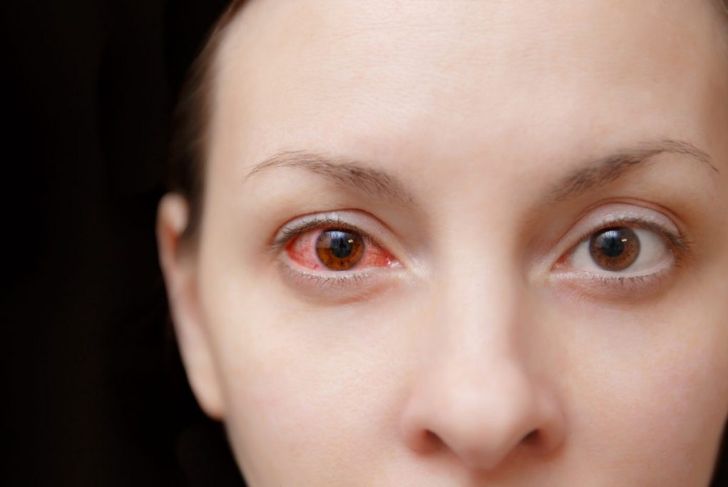Iritis is inflammation that occurs in the iris, the colored ring that surrounds the pupil in the eye. While iritis is the common name for this condition, it is medically known as anterior uveitis. The uvea is the name given to the eye’s internal pigmented parts, including the ciliary body, iris, and choroid. Iritis is the most common type of uveitis and can occur in one or both eyes. If it’s left untreated, an inflamed iris may lead to serious complications, including vision loss. It’s important for someone experiencing iritis symptoms to see an eye doctor right away.
Functions of the Iris
The iris lies between the cornea and the lens and can range in color from light blue to dark brown. The pupil, the black part inside the iris, allows light into the eye. The iris is part of the uvea, the colored middle layer of the eyeball composed of the ciliary body, iris, and choroid. Not only does the iris give each individual a specific eye color, but it also controls the size of the pupil. One of the iris muscles dilates the pupil in dim light while another constricts the pupil in bright light.
Symptoms of Iritis
Iritis typically develops suddenly and can affect one or both eyes. Symptoms include redness, decreased or blurred vision, photophobia (sensitivity to light), and pain that may present as achiness in the eye. If one eye is affected, that pupil may appear smaller than the pupil in the unaffected eye.
Complications of Iritis
If iritis is left untreated or is treated improperly, it can result in serious complications. If someone has chronic iritis, he or she is at risk for cataracts in the affected eye. Additionally, if scar tissue develops in response to iritis, the iris may stick to the cornea or the lens, which can make the pupil irregular in shape. Untreated iritis can also lead to swelling and the formation of fluid-filled cysts in the retina, causing decreased or blurred central vision. Calcium deposits may develop on the cornea, another cause of decreased vision and degeneration. Glaucoma may also develop due to untreated iritis.
Risk Factors for Iritis
Mutation of a gene required for proper immune system functioning raises the risk of developing iritis. Those with weakened immune systems or autoimmune disorders including reactive arthritis and ankylosing spondylitis are also at higher risk for getting iritis. Research indicates smoking adds to the risk, as well, as does contracting sexually transmitted infections such as HIV/AIDS and syphilis.
Causes of Iritis
The cause of iritis is often challenging to determine. Acute iritis can be caused by trauma to the eye, such as a penetrating injury, blunt force trauma, or a fire or chemical burn. Autoimmune diseases, such as psoriatic arthritis, ankylosing spondylitis, Reiter’s syndrome, and inflammatory bowel disease, are linked to iritis. Shingles on the face, juvenile rheumatoid arthritis, Behcet’s disease, and sarcoidosis can cause the condition. In rare cases, certain medications can cause iritis.
When to See a Doctor
For children with juvenile rheumatoid arthritis, iritis can be especially damaging and may not respond to treatment. Pain is often not present in children with juvenile rheumatoid arthritis, so a doctor should always examine red eyes lacking an obvious cause. Adults who have symptoms of iritis should see an eye doctor as soon as possible.
Diagnosing Iritis
A doctor can diagnose iritis with a slit lamp examination. A slit lamp is a microscope containing a light an eye doctor can use to examine the inside of the eye. If iritis is present, an eye doctor will see inflammatory cells in the front part of the eye.
Treatment for Iritis
The goals of iritis treatment are to decrease inflammation and pain and preserve vision. Steroid eye drops can also reduce inflammation. A doctor may also prescribe dilating eye drops to help reduce eye pain and protect against complications that affect the pupil’s ability to function. If the symptoms continue or worsen, the doctor may prescribe oral medications.
Acute Versus Chronic Iritis
Acute iritis typically clears up within days. However, iritis can last for weeks or even months. Iritis may become chronic, and the condition may recur. Iritis tends to recur with autoimmune conditions, such as ankylosing spondylitis and sarcoidosis. An eye doctor may prescribe steroid eye drops to those who are at high risk of recurrent episodes so that they can begin treatment at the first sign of recurrence.
Iritis Prognosis
Most of the time, iritis responds well to treatment. Unfortunately, each time iritis recurs, it puts a person at higher risk of scarring in the eye, cataracts, glaucoma, and other serious eye problems. Left untreated, iritis can lead to complications such as swelling in the retina, calcium deposits on the cornea, and glaucoma.

 Home
Home Health
Health Diet & Nutrition
Diet & Nutrition Living Well
Living Well More
More




















